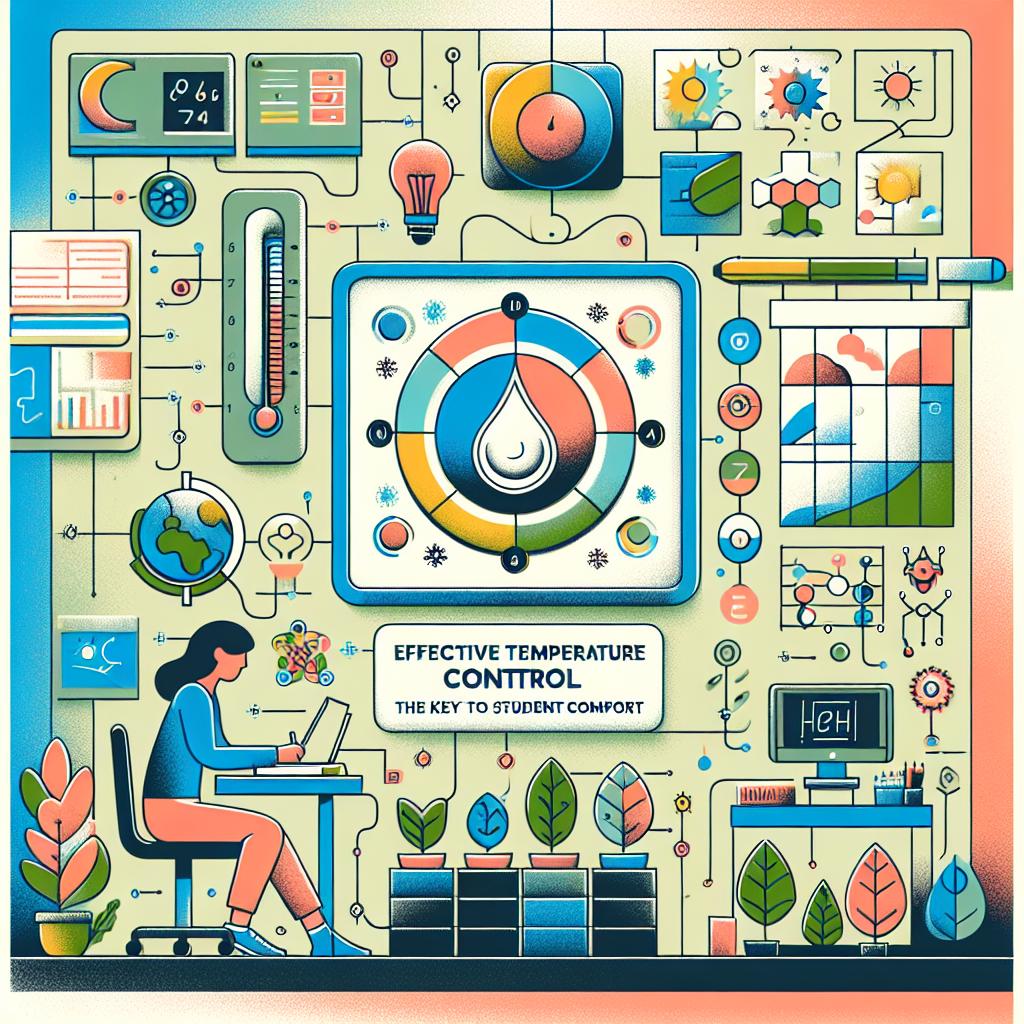In teh evolving landscape of education, where distractions can hinder learning and the climate can impede focus, maintaining an optimal environment in commercial classrooms is more crucial than ever. As temperatures rise and air quality fluctuates, traditional HVAC systems often fall short, leaving students and educators alike uncomfortable and unfocused. Enter the mini split air conditioning system—a powerful yet unobtrusive solution designed to enhance both comfort and air quality. This article explores the many reasons why mini split AC units are not just a luxury, but an essential component for creating conducive learning environments in classrooms. Join us as we delve into how these versatile systems can transform educational spaces into havens of productivity and well-being.
The Role of Mini Split AC in Enhancing Learning Environments
In today’s educational landscape, the importance of a agreeable learning environment cannot be overstated. Mini split AC systems play a pivotal role in creating optimal temperature and air quality conditions that not only support concentration but also enhance overall student performance. These compact units offer targeted cooling solutions and can be individually controlled,allowing for personalized settings that accommodate diverse learning styles and preferences. With whisper-quiet operation and energy efficiency, mini splits enable classrooms to maintain a serene atmosphere that fosters innovation and engagement.
Moreover, the health benefits associated with mini split AC systems are crucial in an educational setting. By providing superior air filtration and humidity control, they help in reducing airborne allergens and pollutants, ensuring that students and teachers breathe cleaner air. This is especially important in today’s context, where indoor air quality has become a priority for health and wellness. Key advantages include:
- improved Academic Performance: Comfortable temperatures help students focus better.
- Reduced Absenteeism: Cleaner air contributes to fewer respiratory issues.
- Flexibility in Design: Easy to install in various classroom layouts.

Understanding the Air Quality Benefits of Mini Split Systems
Mini split systems excel in providing not only cooling comfort but also considerably improving indoor air quality. These systems are designed with advanced filtration technologies that capture a wide array of airborne particles,including dust,allergens,and even certain bacteria. By continuously circulating and purifying the air,mini splits help to maintain a healthier environment in commercial classrooms where students spend extended periods of time. Some key features that contribute to air quality enhancement include:
- Multi-stage filtration: Removes pollutants and contaminants.
- Dehumidification capabilities: reduces moisture levels, preventing mold growth.
- Fresh air intake: Introduces filtered outdoor air into the classroom.
Moreover, the zoned cooling capabilities of mini split systems allow for better control of temperatures and humidity across different areas of a classroom. this precision not only ensures comfort but also minimizes the proliferation of stale air that can harbor pollutants. The energy-efficient design of mini splits results in quieter operation, leading to a conducive learning environment where focus and productivity can thrive. A comparison between traditional AC systems and mini splits illustrates the advantages clearly:
| Feature | Traditional AC Systems | Mini Split Systems |
|---|---|---|
| Air Filtration | Basic filters | Multi-stage filtration |
| Noise level | Frequently enough loud | Whisper-quiet operation |
| humidity Control | limited | Effective dehumidification |

Effective Temperature control: The Key to Student Comfort
Maintaining an optimal learning environment is crucial for student engagement and productivity. Classrooms equipped with mini split air conditioning systems provide precise temperature control, allowing educators to tailor the environment to suit varying preferences throughout the year. These units operate quietly, reducing disruptions during lessons while enhancing overall air quality. Key advantages include:
- Individual Temperature Zones: Students have unique comfort levels; mini splits allow for multiple zones to be independently controlled.
- Energy Efficiency: Designed to optimize energy use, mini splits reduce costs while maintaining ideal climatic conditions.
- Improved Ventilation: These systems help circulate fresh air, minimizing the buildup of pollutants and allergens.
Moreover, effective temperature management contributes to improved focus and performance. When students are comfortable, the likelihood of distractions caused by discomfort diminishes significantly. schools adopting mini splits can experience measurable benefits, making the classroom a more inviting place for learning.A comparison of traditional HVAC systems versus mini splits reveals notable differences:
| Features | Traditional HVAC Systems | Mini Split Systems |
|---|---|---|
| Initial Cost | Higher Installation Costs | Lower Installation Costs |
| Temperature Control | Less Flexible | Highly Adjustable |
| Energy Efficiency | Moderate | High |
| Noise Level | Higher Noise Levels | quiet Operation |

Investing in Mini Split Technology for Long-Term Energy Savings
Investing in mini split technology not only enhances the comfort of commercial classrooms but also yields meaningful energy savings over time. Traditional HVAC systems are frequently enough large and inefficient, consuming excessive energy to maintain temperature control. In contrast,mini splits operate on a zone-based system,allowing for targeted cooling or heating in specific areas. This flexibility means less energy waste, which can lead to reduced utility bills and a lower carbon footprint. By upgrading to mini splits, schools and educational institutions can transition towards creating a more sustainable learning environment that aligns with modern energy standards.
Additionally,the long-term benefits of mini split systems extend beyond just energy savings. With the ability to seamlessly integrate advanced technology features such as programmable thermostats and remote temperature control, schools can further optimize their energy usage based on occupancy and usage patterns. The table below highlights the key advantages of choosing mini split technology:
| Advantage | Description |
|---|---|
| Energy Efficiency | Reduced energy consumption through zoned heating and cooling. |
| Cost Savings | Lower utility bills due to improved efficiency. |
| easy Installation | Less invasive installation process compared to traditional systems. |
| Improved Air Quality | Enhanced filtration systems contribute to better indoor air quality. |
Q&A
Q&A: Why Mini Split AC is Essential for maintaining Comfort and Air Quality in Commercial Classrooms
Q1: What exactly is a mini split AC system?
A1: A mini split AC system is a type of air conditioning unit that consists of two main components: an indoor unit and an outdoor compressor. These systems operate without ductwork, making them more flexible in installation and allowing for individual temperature control in different areas of a building.
Q2: How does a mini split AC enhance comfort in commercial classrooms?
A2: Mini split AC systems provide precise temperature control, allowing each classroom to maintain an optimal learning environment. with the ability to set different temperatures for different rooms, they ensure students are comfortable, which can significantly improve focus and productivity.
Q3: What are the benefits of using mini split AC systems over traditional cooling systems in classrooms?
A3: Mini split AC systems are more energy-efficient, as they target specific areas rather than cooling the entire building. They also operate quietly, minimizing disruptions during lessons, and can improve air quality by filtering out dust and allergens, which is crucial in a classroom setting.
Q4: How do mini split systems contribute to better air quality in classrooms?
A4: Many mini split units come equipped with advanced filtration systems that capture dust, pollen, and other harmful particles. By continuously circulating fresh air and maintaining proper humidity levels, they help create a healthier environment, which is essential for both students and teachers.
Q5: Are mini split AC systems easy to install in existing commercial classrooms?
A5: yes, one of the significant advantages of mini split AC systems is their ease of installation. They require minimal construction compared to traditional ducted systems. This means classrooms can be retrofitted with little disruption to the learning environment.
Q6: How do mini split AC systems impact energy costs?
A6: Mini split AC systems are designed to be energy-efficient, using less electricity than traditional HVAC systems.Their ability to cool specific zones rather than the entire building can lead to substantial cost savings on energy bills, making them a smart investment for educational institutions.
Q7: What features should schools look for when choosing a mini split AC system for classrooms?
A7: Schools should consider factors such as energy efficiency ratings (SEER), noise levels, filtration systems, and ease of operation. Features like programmable thermostats and smart technology can also enhance usability and comfort, allowing for optimal climate management during school hours.
Q8: Can mini split AC systems provide heating as well as cooling?
A8: Absolutely! Many mini split systems are equipped with heat pump technology, enabling them to provide both heating and cooling. This versatility allows classrooms to maintain a comfortable temperature year-round, adapting to the ever-changing weather conditions.
Q9: How do mini split AC systems benefit teachers and staff in the classroom?
A9: Comfortable temperatures enhance concentration and reduce fatigue, which is beneficial for both teachers and students. Additionally,improved air quality can help decrease absenteeism related to allergies or illnesses,contributing to a more effective learning environment.
Q10: why should schools consider investing in mini split AC systems?
A10: Investing in mini split AC systems is a proactive step towards enhancing the overall learning environment. They offer energy efficiency, customizable comfort, improved air quality, and ease of installation—all crucial elements for creating an ideal educational setting. With the long-term benefits they provide, mini split systems are indeed an essential consideration for modern commercial classrooms.
To Conclude
the choice to implement mini split AC systems in commercial classrooms transcends mere temperature regulation; it is an investment in the well-being and productivity of students and educators alike.These systems provide precise temperature control, ensure optimal air quality, and operate with energy efficiency that aligns with modern sustainability goals.As educational environments evolve, so too must our approach to comfort and climate control. By embracing mini split technology, we not only enhance the learning experience but also cultivate spaces where creativity, focus, and innovation can flourish. In an era where every detail counts in fostering effective learning, the mini split AC stands out as an essential ally in creating conducive educational climates for all.

